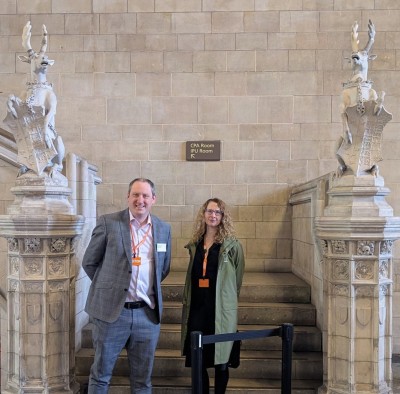Week in Westminster bridges the research-policy gap
Two Surrey academics spent last week in Westminster exploring the world of policymaking as part of the prestigious Royal Society Pairing Scheme, in partnership with the Government Office for Science.
The initiative aims to help build relationships between scientists and politicians, ensuring that policymakers can make decisions based on the best scientific evidence.
Over the course of the week, 30 UK scientists gained a behind the scenes insight into how policy is formed, shadowing a policy maker to learn about their work and how they can best share their expertise.

Professor John Collomosse, Professor of Computer Vision and AI and Director of DECaDE, was paired with the Department for Science, Innovation and Technology (DSIT) team responsible for the UK government’s policy and capability in AI and Disinformation.
Dr Melissa Marselle, Lecturer in Environmental Psychology, whose research highlights the wellbeing benefits of biodiversity and the gap between national policies to enhance biodiversity and the behavioural changes that are critical to making a real difference, was paired with a civil servant in the Natural Capital and Ecosystem Assessment Programme in the Department for Environment, Food and Rural Affairs (Defra).
Here, they share their experiences and takeaways from the week.
What inspired you to apply for the pairing scheme?
John: Our research in DECaDE tackles fake news and disinformation by tracing the provenance (origins) of media. This requires new technologies, but also engagement with policymakers to promote adoption and digital literacy. The scheme offered a great opportunity to learn about, and to create, this kind of policy impact.
Melissa: The natural world is essential for human health and wellbeing – providing us the food, water, air, medicines etc. However, human activity is changing the climate of our planet and destroying biodiversity at an unprecedented rate. To save nature - and ourselves - we need to change our behaviour and reframe how we see the natural world. To do this, I apply behavioural insights to nature conservation policies, and study the mental health benefits of biodiversity. I applied for the pairing scheme aim to collaborate with policymakers to help make environmental policies more effective by incorporating behavioural insights, and highlight the co-benefits of nature conservation across policy areas for human health and climate change.
Tell us a bit about your paired policy maker..
John: I was placed with the team in DSIT responsible for policy in tackling online harms and disinformation, and for making recommendations to government in this space. I was delighted to find a pairing with such a close alignment to my research area!
Melissa: My policy maker is a natural scientist, with a PhD in Marine Geology, who works within the Natural Capital and Ecosystem Assessment Programme in Defra where he advises and integrates interactive maps to monitor the extent, location and condition of nature across England to meet environmental policy goals.
What was your highlight of the week?
John: I was fortunate to have the chance to meet with several policymakers involved in guiding emerging legislation in online harms, and other areas where media provenance can help such fair use of data in training AI.
Melissa: There were so many! But the absolute highlight of the programme was gaining access to spaces that I would otherwise not have access to. An evening reception at the House of Lords and stepping in to the Royal Society were surreal.
What is the potential impact, and what actions will you be taking, for policy engagement in your own research area?
John: The week gave me a new awareness of the information architecture that exists between the civil service and ministers, and how to engage effectively at the right level of the kinds of policy impact you hope to create.
Melissa: I will practice short writing policy briefs or summaries of my research articles and sending these to relevant civil servants I have met at Defra during the pairing scheme. My pair, from Defra, will be visiting the Environmental Psychology Research Group in the School of Psychology here at Surrey in May. During that time, we will co-create a presentation for Defra’s natural capital team on the research linking biodiversity to human health.
What’s your top tip for colleagues interested in policy engagement?
John: As a scientific expert, your role is often to describe the “art of the possible” to policymakers today vs. tomorrow in terms of stakeholders and outcomes. Keeping the message focused without extraneous technical detail will preserve its clarity as it is, hopefully, replayed to decision makers.
Melissa: Policymakers do not read journal articles. You need to develop new avenues for providing your research to them. Write the outputs of your article in a one-page summary – and upload it somewhere that is open access. Sign up to the UK Parliament Knowledge Exchange Unit’s ‘weekly round-up email of opportunities’ for the research community to engage with UK Parliament.
Get involved
If you’re inspired to share your research with policymakers, you can keep up to date with future policy opportunities and learn more about steps you can take to engage by joining Surrey Policy Network here, and following us on LinkedIn.
Our next ‘Introduction to Policy Engagement’ webinar is on Wednesday 9th April, 2 – 3pm. Register here.